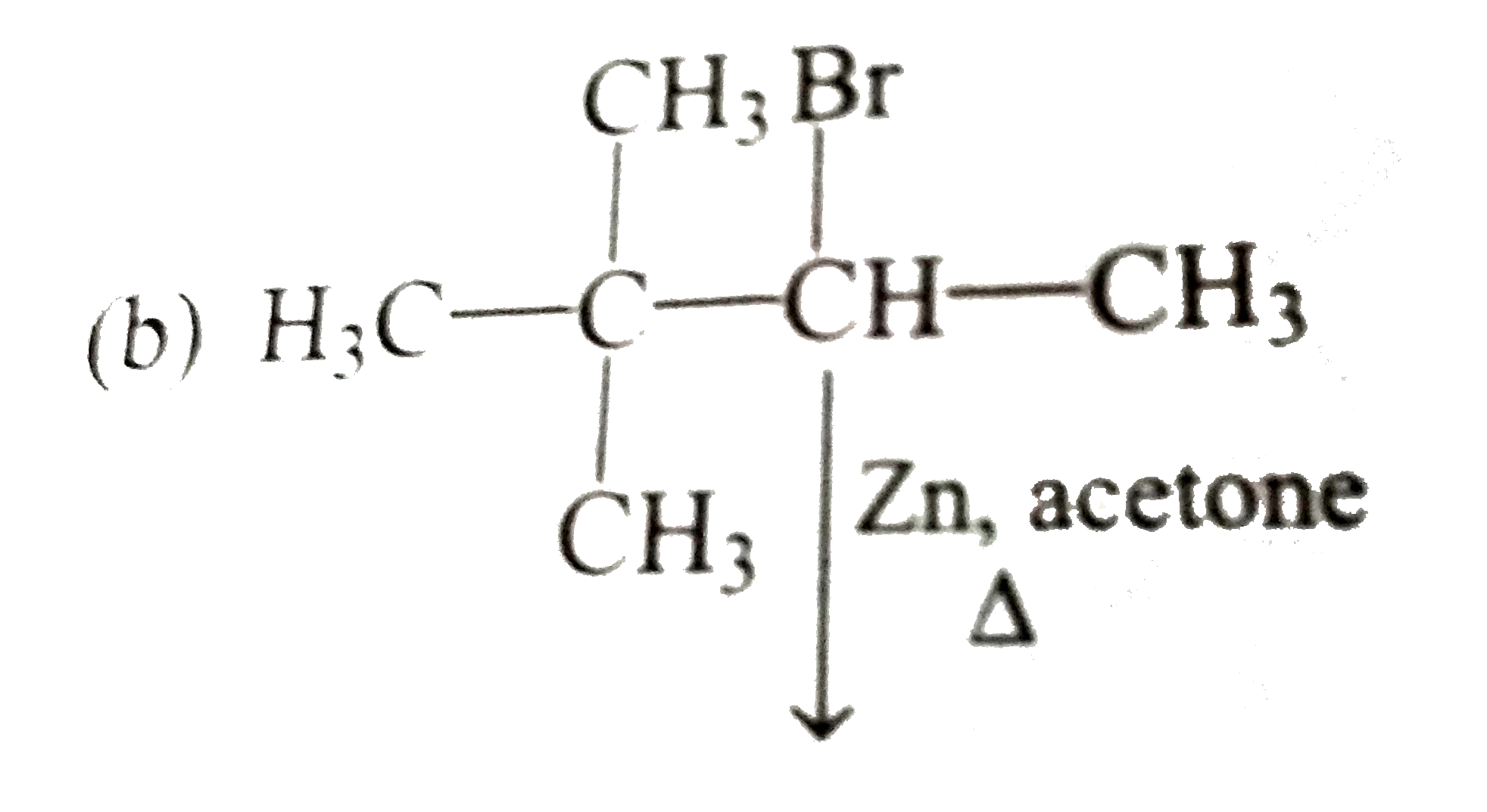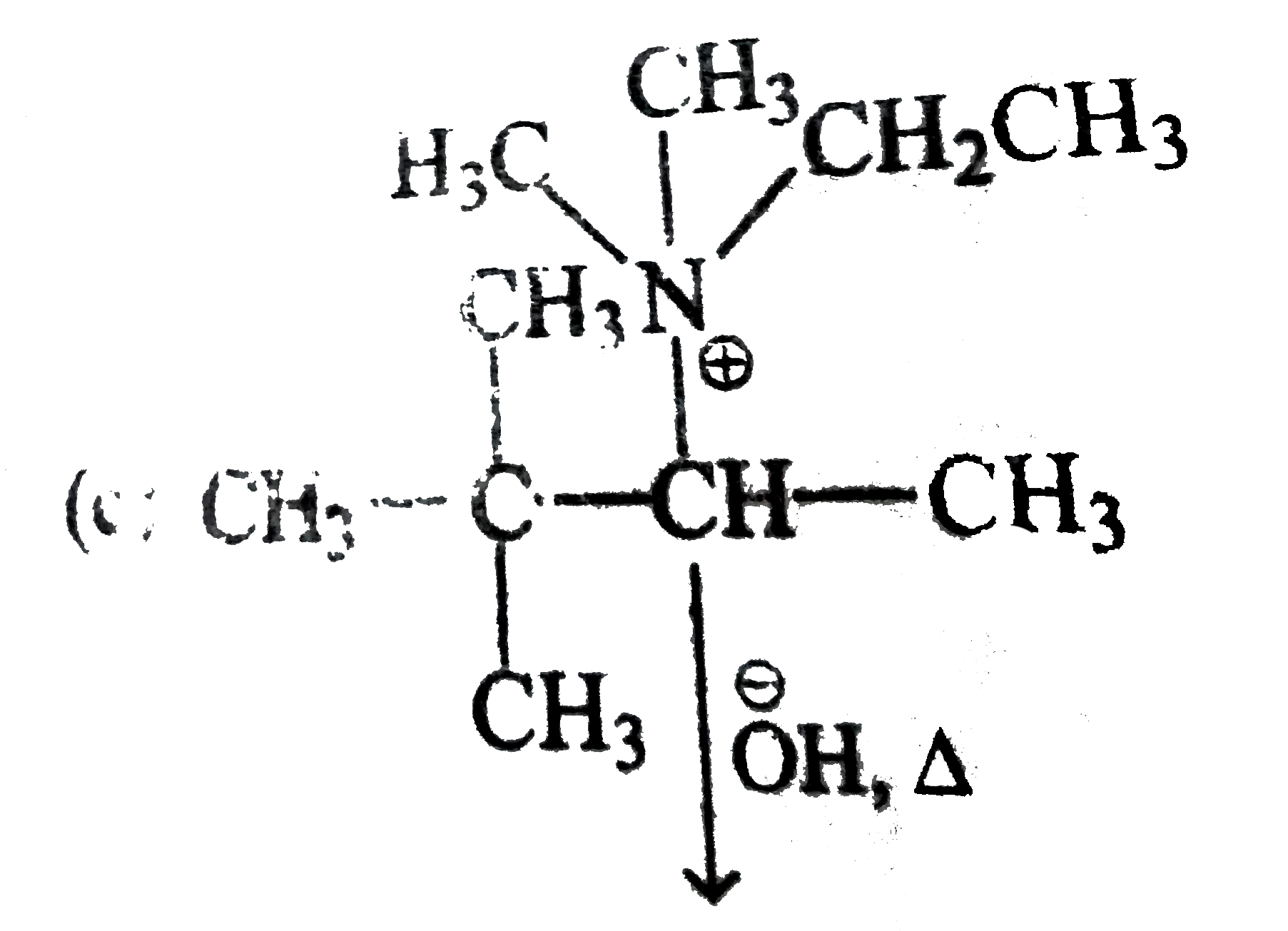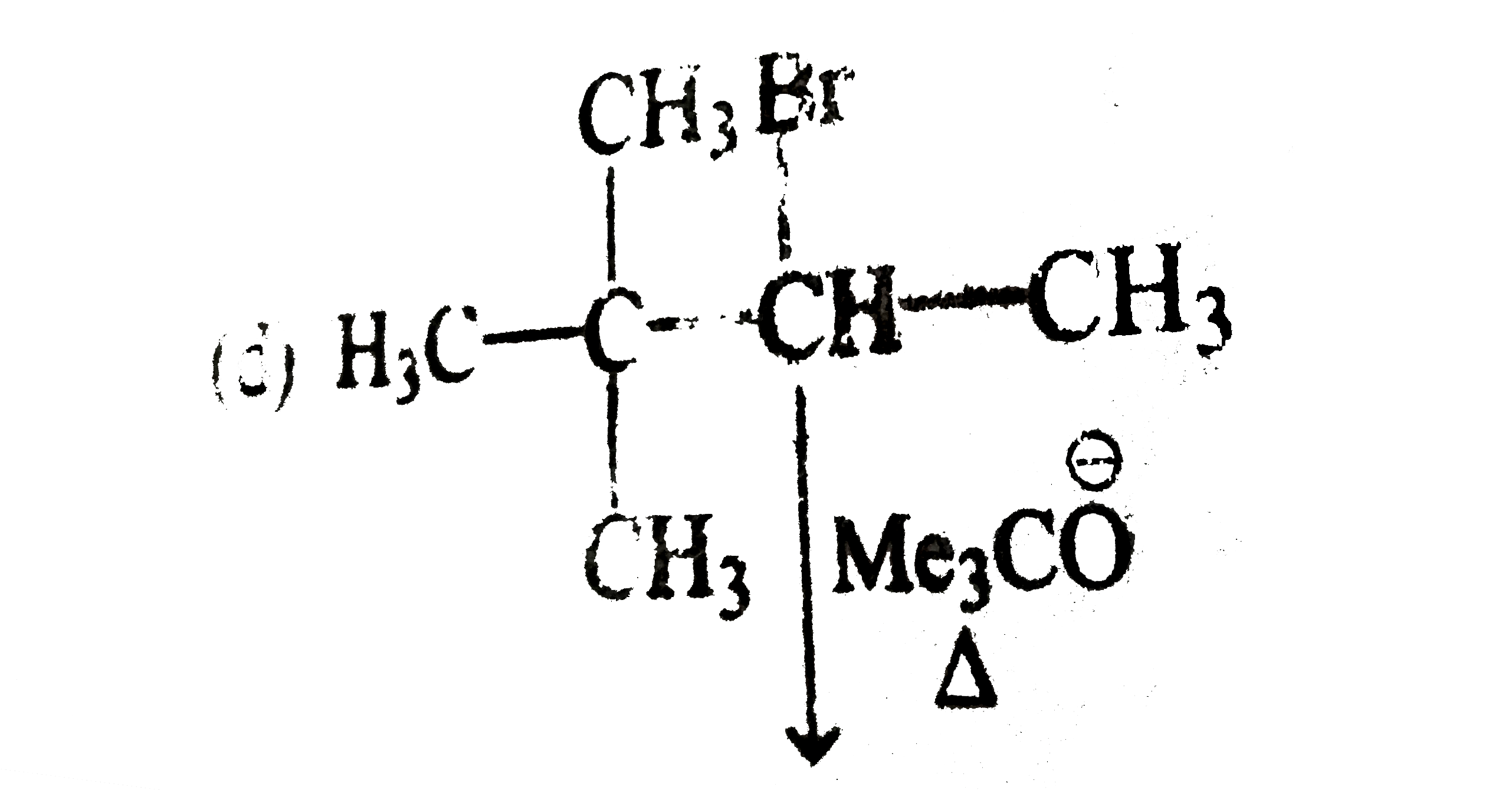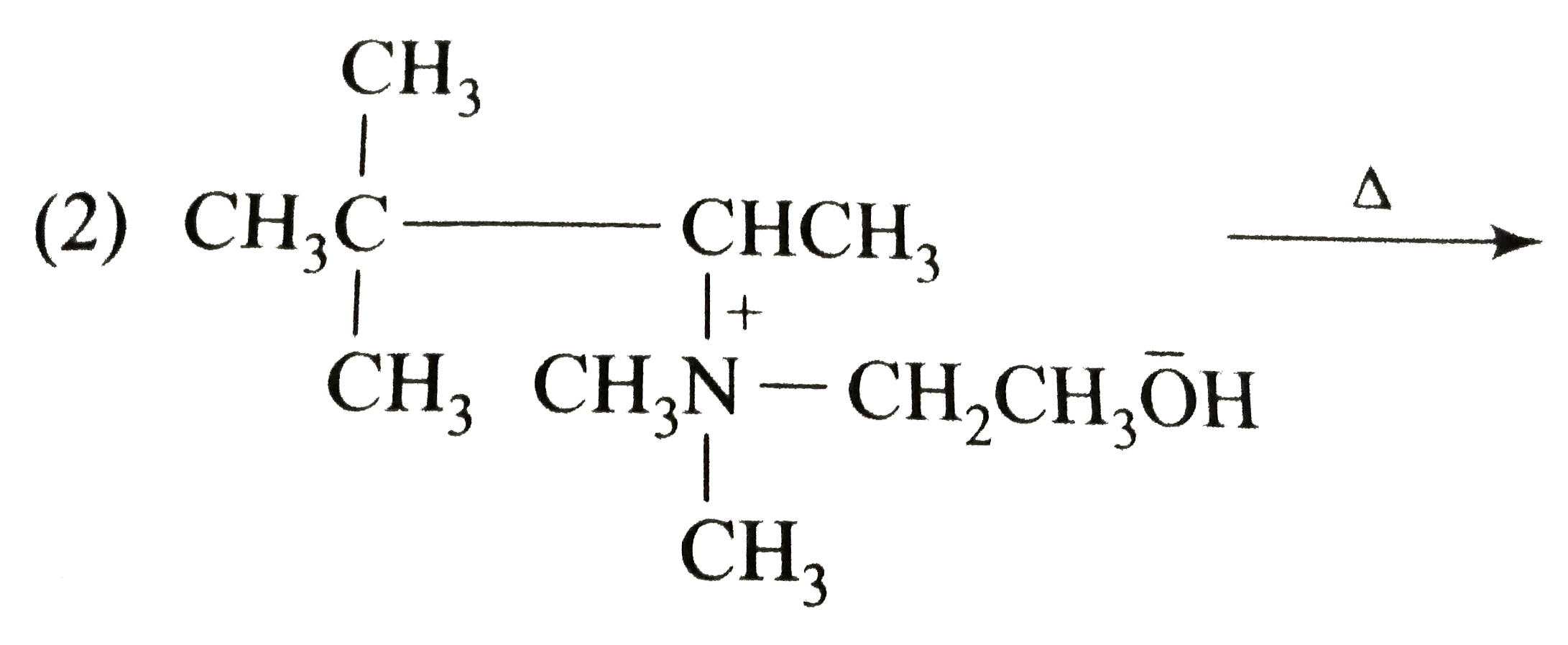Which of the following reactions is expected to give a fairalyt good yield of (CH_(3))_(3)C-CH=CH_(2)?





The correct Answer is:D
To determine which reaction is expected to give a fairly good yield of the alkene (CH₃)₃C−CH=CH₂, we need to analyze the given options step by step.
1. Identify the Alkene Structure:
The target alkene is (CH₃)₃C−CH=CH₂, which is a branched alkene with a double bond between the last two carbon atoms.
2. Evaluate Each Option:
We have four options (A, B, C, and D) to analyze.
- Option A:
- The reaction involves protonation of an alcohol followed by carbocation formation.
- The carbocation formed is a secondary carbocation, which can rearrange to a more stable tertiary carbocation.
- However, the final product after deprotonation leads to a more stable alkene, which does not match our target alkene.
- Conclusion: Option A does not yield the desired alkene.
- Option B:
- This option also involves a similar mechanism where a bromine atom leaves, forming a carbocation.
- The carbocation can rearrange to a more stable tertiary carbocation.
- The final product after deprotonation is again a more stable alkene, which is not the target alkene.
- Conclusion: Option B does not yield the desired alkene.
- Option C:
- This reaction involves a nitrogen-containing compound that can also form a carbocation.
- Similar to the previous options, the carbocation rearranges to a more stable tertiary carbocation.
- The product after deprotonation is again a more stable alkene, which does not match the target alkene.
- Conclusion: Option C does not yield the desired alkene.
- Option D:
- The reaction involves a bulky base (Me₃CO⁻) reacting with a suitable substrate.
- The bulky base abstracts a proton from the less hindered carbon, leading to the formation of the desired alkene.
- The final product after this reaction matches our target alkene (CH₃)₃C−CH=CH₂.
- Conclusion: Option D yields the desired alkene.
3. Final Answer:
The reaction expected to give a fairly good yield of (CH₃)₃C−CH=CH₂ is Option D.
The target alkene is (CH₃)₃C−CH=CH₂, which is a branched alkene with a double bond between the last two carbon atoms.
We have four options (A, B, C, and D) to analyze.
- The reaction involves protonation of an alcohol followed by carbocation formation.
- The carbocation formed is a secondary carbocation, which can rearrange to a more stable tertiary carbocation.
- However, the final product after deprotonation leads to a more stable alkene, which does not match our target alkene.
- Conclusion: Option A does not yield the desired alkene.
- This option also involves a similar mechanism where a bromine atom leaves, forming a carbocation.
- The carbocation can rearrange to a more stable tertiary carbocation.
- The final product after deprotonation is again a more stable alkene, which is not the target alkene.
- Conclusion: Option B does not yield the desired alkene.
- This reaction involves a nitrogen-containing compound that can also form a carbocation.
- Similar to the previous options, the carbocation rearranges to a more stable tertiary carbocation.
- The product after deprotonation is again a more stable alkene, which does not match the target alkene.
- Conclusion: Option C does not yield the desired alkene.
- The reaction involves a bulky base (Me₃CO⁻) reacting with a suitable substrate.
- The bulky base abstracts a proton from the less hindered carbon, leading to the formation of the desired alkene.
- The final product after this reaction matches our target alkene (CH₃)₃C−CH=CH₂.
- Conclusion: Option D yields the desired alkene.
The reaction expected to give a fairly good yield of (CH₃)₃C−CH=CH₂ is Option D.
Topper's Solved these Questions
- HYDROCARBONS (ALKANE, ALKENE and ALKYNE)Book:HIMANSHU PANDEYChapter:HYDROCARBONS (ALKANE, ALKENE and ALKYNE)Exercise:Level 2 (Q.101 To Q.125)
Explore 25 Videos
- HYDROCARBONS (ALKANE, ALKENE and ALKYNE)Book:HIMANSHU PANDEYChapter:HYDROCARBONS (ALKANE, ALKENE and ALKYNE)Exercise:Level 2 (Q.126 To Q.150)
Explore 24 Videos
- HYDROCARBONS (ALKANE, ALKENE and ALKYNE)Book:HIMANSHU PANDEYChapter:HYDROCARBONS (ALKANE, ALKENE and ALKYNE)Exercise:Level 2 (Q.51 To Q.75)
Explore 25 Videos
Similar Questions
Which of the following pairs is expected to exhibit H-bonding
(a) CH3CH2OH and CH3OCH3
(b) CH3NH2 and CH3SH
(c ) CH3OH and (CH3)3N .
View SolutionWhich of the following compounds gives fastest reaction with HBr and why?
(i) (CH3)3_OH (ii) CH3CH2CH2OH
(iii) CH3OH∣CHCH3 (iv) CH3CH3∣CHCH2OH
View Solution
Knowledge Check
Which of the following reactions is expected to given a fairly good yield of (CH3)3CCH=CH2?
ACH3CH3∣C∣CH3−CH∣BrCH3zn−−−−−→AcetoneHeatB CCH3CH3∣C∣CH3−C∣OHHCH3H2SO4−−−→HeatDCH3CH3∣C∣CH3−C∣BrHCH3(CH3)3CO−K+−−−−−−−−−−→Heat
CCH3CH3∣C∣CH3−C∣OHHCH3H2SO4−−−→HeatDCH3CH3∣C∣CH3−C∣BrHCH3(CH3)3CO−K+−−−−−−−−−−→HeatWhich of the following reactions will produce the 2-pentyne in good yield?
CH3−CH2−C≡C−CH3A BCH3−C≡CNaCH3CH2Br−−−−−−→CCH3−CH2−O∣∣C−HCH3CH2MgBr−−−−−−−−→Et2OH3O+−−−→DCH3−CH2−CH2−C∣BrH−CH2−BrNaOH−−−→heat
BCH3−C≡CNaCH3CH2Br−−−−−−→CCH3−CH2−O∣∣C−HCH3CH2MgBr−−−−−−−−→Et2OH3O+−−−→DCH3−CH2−CH2−C∣BrH−CH2−BrNaOH−−−→heatWhich of the following reactions are expected to give
CH3−CH3∣C∣CH3−CH=CH2 in yeilds of more than 50% ?
ACH3−CH3∣C∣CH3−CH∣OH−CH3H2SO4−−−→ΔBCH3−CH3∣C∣CH3−CH∣Br−CH3(CH3)3CO−K+−−−−−−−−−−→ΔCCH3−CH3∣C∣CH3−CH∣Br−CH3Zn−−−−→AcetoneDNone of the above
Which one in each of the following pairs is expected to exhibit hydrogen bonding together ?
(a) CH3−CH2−OHandCH3−O−CH3
(b) CH3NH2andCH3SH
(c ) CH3OCH3and(CH3)3N
View SolutionGive the products of the following reactions : –
CH3−CH3∣C∣CH3−CH=CH2HBr−−→
3, 3-dimethyl - 1 - butene
View SolutionWhich of the following reaction with (CH3CH2)2NH to give the compound?
CH3CH2CH=CHN(CH2CH3)2
View SolutionWhich of the following graphs is correct for the following reaction?
CH3−CH2CH=CH2H2/Ni−−−→300∘CCH3−CH2−CH2−CH3
View SolutionWhich of the following statement is correct for the given compounds ?
CH3−CH=CH2(b)CH3−C≡CH
View Solution